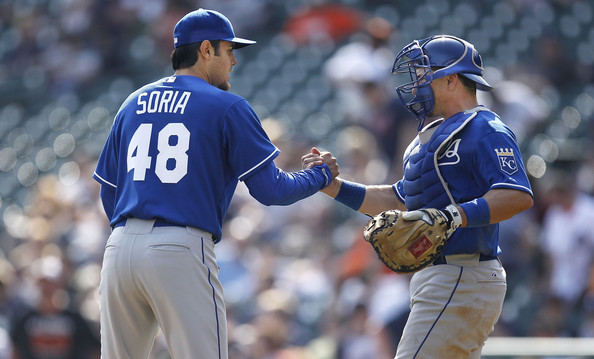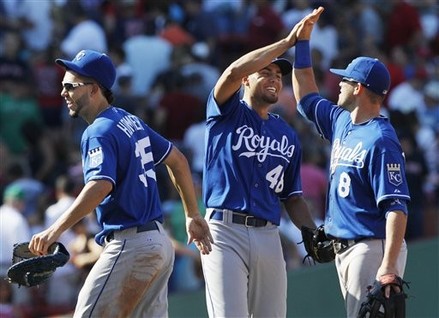Joakim Soria to Undergo a 2nd Tommy John Surgery: The Aftermath of the Loss of the Royals Closer
Saturday March 24th, 2012
Jonathan Hacohen: I was digging in the MLB reports archive this morning, thinking about the recent news on Joakim Soria‘s seasoning ending injury. The inevitable story came out yesterday, as Joakim Soria is facing a second Tommy John surgery. A visit to Dr. Andrews confirmed it. With “definite damage” to the elbow, as was reported from Soria’s initial prognosis, it was only a matter of time till this announcement was made. So the Royals lose Soria for the season, their top closer facing a long road to return after the reconstructive elbow surgery he is about to face. Did the Royals take too much of a risk by hanging on to Soria this offseason? As a result, what is the Royals bullpen going to look like in 2012?Back on November 15th, I prepared a feature titled “Time Has Come For the Royals to Trade Soria“. Now I’m not a big fan of saying “I told you so”…but in this case…you get the idea. Three thoughts come into my mind. Depending on what is true- the Royals had either no choice but to hang on to Soria, or they took an unnecessary gamble. Thought 1: The Royals knew or had a very good idea that Soria’s elbow was injured and he would have never passed a physical. If this is the case, then the Royals had no choice but to hang on to Soria and take their chances. Thought 2: If the Royals knew that Soria’s elbow was in poor health, did they really think that rehab instead of surgery would fix it? Teams make this mistake time and time again. I can’t even begin to consider how many times I heard that a team was going to try aggressive rehab with a player that had a difficult surgery, opting later (weeks or months afterwards) to finally recommend a surgery. If this is the story with Soria, surgery could have been an option then at the end of the season- rather than right before opening day. Soria could have been 6 months into his recovery, rather than a year behind now. But again, without the full story- this is tough to tell.
Then we come to Thought #3: If the elbow injury was unknown a the end of the season and Soria would have passed a physical, why was he not traded? There are many considerations here, including the effect of Soria on the bullpen, his popularity among the fans, reasonable salary and perhaps the Royals did not receive back in trade offers what they expected. Back in November, I was firm in my conviction that Soria had to be traded before the 2012 season. At still a fairly high trade value, I felt that the Royals were taking an unnecessary risk by hanging on to him. Injuries played a key part in my determination, but also the benefit/cost analysis in considering whether to trade the closer. If he had a good season, I didn’t see Soria’s value rising much. But if he would have had a poor 2012, his value would have plummeted too much. This is all speculation at this point, given that Soria is now untradeable and has a long road back to the majors. But the Royals in my opinion took too much of a risk by hanging on to their closer and clearly lost that bet.
I want to state that by no means am I trying to put down the Royals or Joakim Soria. If you follow my writing, you will know that I am a supporter of both. I remember Soria’s perfect game in the Winter League in Mexico back in December 2006. The Royals took him in the Rule-5 draft back then and I had a feeling that they were taking someone very special. Soria took a hold of the closer job in his rookie season of 2007 and never looked back. The big red flag in the back of mind, was a conversation that I had with Soria’s cousin in Mexico back in 2007. The young man indicated to me that Soria was always a legend in Mexico from a young age, as he was throwing a devastating curveball by around the age of 10 years old. I thought to myself: curveball? A good curveball at 10? This is not good for his elbow? This is why coaches tell kids not to touch a curveball until 16. The damage that this pitch can have on a young pitcher’s arm can be devastating. Two Tommy John surgeries later, Soria is living proof. So while I am a big admirer of the Royals’ closer, I always saw him as a an injury ticking time-bomb.
The Royals will be fine going into 2012. While they will miss Soria, they definitely have the arms to replace him. Jonathan Broxton, Greg Holland and Aaron Crow will all get save opportunities, while I see Tim Collins and even Luke Hochevar as darkhorse candidates. With that amount of depth, the Royals protected themselves nicely in the event of a Soria injury. But even with insurance on the roster, the preference would have been to use Soria in the 9th inning in 2012. Soria for the last five seasons has been the rock at the back-end of the Royals pen. His numbers have been spectacular and at 27, he was just entering the prime of his career.
But what are the chances we will see Soria ever come back into form? It is very tough to say, as few pitchers can return to peak levels after multiple Tommy John procedures. Chris Capuano is a recent case of a pitcher trying to revive his career after a 2nd Tommy John. He is still active and while he has had moderate success, it is unlikely he will ever reach his past glory. Other pitchers have included Jose Rijos, Darren Dreifort and Al Reyes. The Royals will have big decisions, as they will be paying Soria $6 million this season and hold team options for the 2013 and 2014 seasons at approximately $8 million per season. The likely result is that Soria will be bought out, with the Royals trying to bring him back on an incentive-based contract. Regardless of where Soria pitches in 2013, the hope is that with modern technology and a year of rehab, we will eventually see the Soria of old return. I am not betting on this happening, but I at least think we should be able to see Joakim Soria back in a major league uniform for at least a few years. He is a grinder and a very determined young man. Hopefully all these years of throwing curveballs as a youngster haven’t resulted in his career ending at this premature stage. If nothing else, this should be a lesson to young pitchers and their parents: stay away from the curveball at a young age. The long-term effects can be too powerful on a young arm.
 Jonathan Hacohen is the Lead Baseball Columnist & Editor for MLB reports: You can follow Jonathan on Twitter (@JHacohen)
Jonathan Hacohen is the Lead Baseball Columnist & Editor for MLB reports: You can follow Jonathan on Twitter (@JHacohen)
Please e-mail us at: mlbreports@me.com with any questions and feedback. You can follow us on Twitter and become a fan on Facebook . To subscribe to our website and have the daily Reports sent directly to your inbox , click here and follow the link at the top of our homepage.
Posted on March 24, 2012, in MLB Player Profiles and tagged baseball, broxton, closer, crow, hochevar, holland, joakim soria, mlb, nathan, papelbon, rivera, royals, saves, soria, worldseries. Bookmark the permalink. Comments Off on Joakim Soria to Undergo a 2nd Tommy John Surgery: The Aftermath of the Loss of the Royals Closer.



You must be logged in to post a comment.